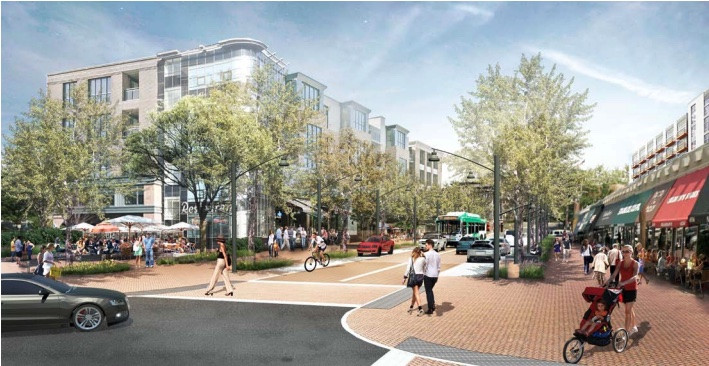Here’s the latest on Arlington’s growth plan along Route 29

A rendering of a reenvisioned US Route 29 from a 2016 Lee Highway Visioning Study.
Plan Lee Highway, Arlington’s long-awaited plan for future growth along US Route 29*, is slowly but surely moving forward. A few years ago, contributor Taylor Reich wrote about the plan when the county was still in the study phase. Now, Arlington county staff have produced different future land use scenarios for five sections, or neighborhood areas, of the corridor.
These scenarios offer different visions for the route that note anticipated intensity and uses of land as well as potential future transportation and public space improvements. Ultimately, the initiative will culminate in an area plan that will guide future development along the corridor over the next 30 years.
Now, the county is seeking public feedback on the different land-use scenarios.
Why the plan matters
Five distinct neighborhood areas identified in Plan Lee Highway. Image available from Arlington County. 
Like many jurisdictions in the Washington region, Arlington is growing. And with continued job growth in the region, which is particularly acute in northern Virginia, Arlington needs more housing to accommodate this growth. A study by the Urban Institute and the Washington Metropolitan Council of Governments, which set targets for every jurisdiction in the region, estimated that Arlington needs to build about 20,900, net new units by 2030 to keep up with population growth.
Arlington’s own Affordable Housing Master Plan calls for 15,800 new affordable housing units by 2040, with 2,500 of these units planned for the US Route 29 corridor (see diagram below).
Arlington’s Affordable Housing Master Plan Guide for Affordable Housing Distribution, 2040. Image from Arlington Affordable Housing Master Plan. 
With the existing metro corridors becoming increasingly built out, pressure is mounting to allow more development in other parts of the county, such as north Arlington, which has traditionally produced little new housing.
Because Route 29 is a major corridor spanning all of north Arlington from Rosslyn to East Falls Church, many believe this is an ideal place for new growth. The corridor is centrally-located and well-connected to employment centers, especially with improved transportation services.
In 2016, prior to the formal Plan Lee Highway process, community leaders across north Arlington came together to adopt a new vision for the corridor in an effort to proactively plan for new development. In this vision, stakeholders expressed hope that new development might help revitalize US Route 29 into a more walkable, diverse, economically vibrant, and transit-rich environment.
This study spurred the county’s own planning process that we are witnessing today. Although, to be sure, there is plenty of concern about the possible negative effects of new development, plenty of optimists remain who believe that new development can bring much-needed improvements to public space and connectivity.
How you can weigh in
A sample question from the feedback form. 
A sample question from the feedback form. 
At this stage, the online portal is open to the public and feedback is due by June 20. The portal allows community stakeholders to review proposed scenarios and leave specific or general comments about each neighborhood area. The county will review the comments and produce a preferred Concept Plan to be reviewed later this year.
For those interested in learning more, the county has a website full of materials about the process here. You can also follow the community process by following the Lee Highway Alliance or, if you live in Arlington, contacting your local civic association or elected official.
(*Note: As the plan’s name states, US Route 29 is currently known as Lee Highway, titled after a Confederate general. As the GGWash style guide policy is to avoid using names that memorialize Confederate soldiers, I refer to the highway as US Route 29 in this article, except when referencing the eponymous county plan. In a separate process, US Route 29 may soon be renamed by the Arlington County Board.)
